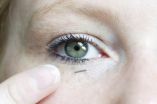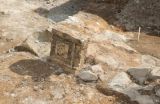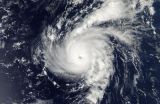(Press-News.org) Sticking yourself in the finger day after day: For many diabetics, this means of checking blood glucose is an everyday part of life. Especially for patients with Type-1 diabetes, who always have to keep a close eye on their levels, since their bodies are incapable of producing the insulin to break down the glucose in the blood. Several times a day, they have to place a tiny drop of blood on a test strip. It is the only way they can ascertain the blood glucose value, so they can inject the correct amount of insulin needed. And this pricking is not only a burdensome: it may also cause inflammation or cornification of the skin. And for pain-sensitive patients, the procedure is agony.
The daily sticking of the finger may soon become a thing of the past, thanks to a diagnostic system with Fraunhofer technology built-in. The underlying concept is a biosensor that is located on the patient's body. It is also able to measure glucose levels continuously using tissue fluids other than blood, such as in sweat or tears. The patient could dispense with the constant needle pricks. In the past, such bioelectric sensors were too big, too imprecise and consumed too much power. Researchers at the Fraunhofer Institute for Microelectronic Circuits and Systems IMS in Duisburg have recently achieved a major breakthrough: They have developed a biosensor in nano-form that circumvents these hurdles.
Diagnostic system in miniature
The principle of measurement involves an electrochemical reaction that is activated with the aid of an enzyme. Glucose oxidase converts glucose into hydrogen peroxide (H2O2) and other chemicals whose concentration can be measured with a potentiostat. This measurement is used for calculating the glucose level. The special feature of this biosensor: the chip, measuring just 0.5 x 2.0 millimeters, can fit more than just the nanopotentiostat itself. Indeed, Fraunhofer researchers have attached the entire diagnostic system to it. "It even has an integrated analog digital converter that converts the electrochemical signals into digital data," explains Tom Zimmermann, business unit manager at IMS. The biosensor transmits the data via a wireless interface, for example to a mobile receiver. Thus, the patient can keep a steady eye on his or her glucose level. "In the past, you used to need a circuit board the size of a half-sheet of paper," says Zimmermann. "And you also had to have a driver. But even these things are no longer necessary with our new sensor."
Durable biosensor
The minimal size is not the only thing that provides a substantial advantage over previous biosensors of this type. In addition, the sensor consumes substantially less power. Earlier systems required about 500 microamperes at five volts; now, it is less than 100 microamperes. That increases the durability of the system – allowing the patient to wear the sensor for weeks, or even months. The use of a passive system makes this durability possible. The sensor is able to send and receive data packages, but it can also be supplied with power through radio frequency.
The glucose sensor was engineered by the researchers at Noviosens, a Dutch medical technology firm. Since it can be manufactured so cost-effectively, it is best suited for mass production. These non-invasive measuring devices for monitoring blood glucose levels may become the basis for a particularly useful further development in the future: The biochip could control an implanted miniature pump that, based on the glucose value measured, indicates the precise amount of insulin to administer. That way, diabetes patients could say goodbye to incessant needle-pricks forever.
INFORMATION:
Measuring glucose without needle pricks
2012-09-07
ELSE PRESS RELEASES FROM THIS DATE:
Unemployment causes more mental health problems among Somalis in London than in Minneapolis
2012-09-07
Somali immigrants to the UK and USA appear to integrate better and have fewer mental health problems if they are allowed to work and they receive practical support during the first few years of their time in the new country, according to a study led by researchers at Queen Mary, University of London (UK) and published in BioMed Central Public Health today (Friday). [1]
The study used a survey and focus groups to investigate the experiences of Somalis living in London (UK) and Minneapolis (USA). After adjusting for various factors such as age, sex and marital status, the ...
Archaeologists uncover 'lost garden' in quest for Richard III
2012-09-07
Archaeologists from the University of Leicester who are leading the search for the lost grave of King Richard III announced today that they have made a new advance in their quest.
They have uncovered evidence of the lost garden of Robert Herrick – where, historically, it is recorded there was a memorial to Richard III.
Now the 'time tomb team' as they have become to be known has discovered paving stones which they believe belong to the garden.
The University of Leicester is leading the archaeological search for the burial place of King Richard III with Leicester City ...
Premier global health journal, The Lancet, releases series on universal health coverage
2012-09-07
Washington D.C., September 7, 2012 – Every year 100 million people are pushed into poverty because they have to pay for health services directly. With support from the Rockefeller Foundation, Results for Development Institute has partnered with the world's premier global health journal, The Lancet, on a special collection of papers exploring the social, political, and economic issues around the global movement towards universal health coverage (UHC) – defined by the World Health Organization as everyone in a population having access to appropriate, promotive, preventive, ...
Antibiotic therapy improves moderate exacerbations of mild-to-moderate COPD
2012-09-07
Antibiotic treatment with amoxicillin/clavulanate improves moderate exacerbations in patients with mild-to-moderate chronic obstructive pulmonary disease (COPD) and significantly prolongs the time between exacerbations, according to a new study from researchers in Spain.
"The existing evidence for antibiotic therapy in non-severe exacerbations of COPD is weak," said lead author Carl Llor, MD, PhD of the University Rovira i Virgili in Tarragona, Spain. "The results of our multicenter, randomized, double-blind, placebo-controlled trial show that antibiotic treatment is ...
Towards computing with water droplets -- superhydrophobic droplet logic
2012-09-07
Researchers in Aalto University have developed a new concept for computing, using water droplets as bits of digital information. This was enabled by the discovery that upon collision with each other on a highly water-repellent surface, two water droplets rebound like billiard balls.
In the work, published in the journal Advanced Materials, the researchers experimentally determined the conditions for rebounding of water droplets moving on superhydrophobic surfaces. In the study, a copper surface coated with silver and chemically modified with a fluorinated compound was ...
Istanbul -- The earthquake risk of a megacity
2012-09-07
Today the drilling starts for a seismic monitoring network on the Marmara Sea near Istanbul. Specially designed seismic sensors in eight boreholes on the outskirts of Istanbul and around the eastern Marmara Sea will monitor the seismic activity of the region with high precision. In each of the respective 300 meter deep holes several borehole seismometers will be permanently installed at various depths. These detect even barely perceptible earthquakes with very small magnitudes at a high resolution and can thus provide information about the earthquake rupture processes associated ...
University of Toronto scientists cast doubt on renowned uncertainty principle
2012-09-07
TORONTO, ON – Werner Heisenberg's uncertainty principle, formulated by the theoretical physicist in 1927, is one of the cornerstones of quantum mechanics. In its most familiar form, it says that it is impossible to measure anything without disturbing it. For instance, any attempt to measure a particle's position must randomly change its speed.
The principle has bedeviled quantum physicists for nearly a century, until recently, when researchers at the University of Toronto demonstrated the ability to directly measure the disturbance and confirm that Heisenberg was too ...
Ancient, bottom-dwelling critter proves: Newer isn't always better
2012-09-07
BUFFALO, N.Y. -- Tiny sea creatures called rhabdopleurids reside on the ocean floor, building homes of collagen on the shells of dead clams. Rhabdopleurid colonies are small, and the critters are by no means the dominant animals in their ecosystem.
But they have lived this way -- and survived -- for more than 500 million years. And in doing so, they have outlasted more elaborate species that also descended from a common ancestor, according to a new study in the journal Lethaia.
Though rhabdopleurids' age and modern existence are well-documented, the paper breaks new ground ...
Strategy developed to improve delivery of medicines to the brain
2012-09-07
New research offers a possible strategy for treating central nervous system diseases, such as brain and spinal cord injury, brain cancer, epilepsy, and neurological complications of HIV. The experimental treatment method allows small therapeutic agents to safely cross the blood-brain barrier in laboratory rats by turning off P-glycoprotein, one of the main gatekeepers preventing medicinal drugs from reaching their intended targets in the brain.
The findings appeared online Sept. 4 in the Proceedings of the National Academy of Sciences, and is the result of a study from ...
NASA keeping an 'eye' on Hurricane Michael
2012-09-07
Hurricane Michael's eye was so clear on new satellite imagery from NASA that the surface of the Atlantic Ocean could be seen through it.
NASA satellites have provided visible, infrared and microwave imagery of Hurricane Michael as it tracks north in the eastern Atlantic. A stunning visible image of Hurricane Michael was taken by the Moderate Resolution Imaging Spectroradiometer (MODIS) instrument that flies aboard NASA's Aqua satellite on Sept. 6 at 12:20 p.m. EDT. In the image, Michael's eye was so clear that the ocean surface is visible through it. Since that time infrared ...




